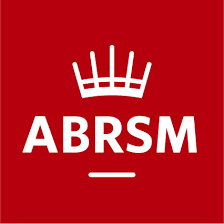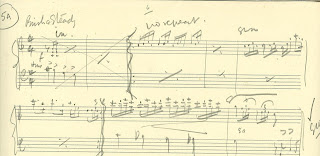Exam time
It's that time of year again - exam season. Schools and universities across the country are busy as young people get ready for those all important exams. In the world of music it's a busy time too, as instrumental examinations take place. In the United Kingdom these usually take place three times a year, with the Associated Board of the Royal Schools of Music (ABRSM) and Trinity College being the "big two". There are now plenty of other instrumental options available including the London College of Music, which has been particularly good at opening up the field of popular music, Victoria College of Music and Drama, with an inclusive approach that covers a wide range of instruments, and the more recent Rockschool, with its emphasis on contemporary music, to name just a few.
Many children (including myself) first came across William Alwyn when one of his works popped up in the syllabus for their grade exam. In my case it was the short piano work The sea is angry for a Grade III Trinity College exam.
Inspired by his mentor J.B. McEwen, who was a regular contributor to the work of the Associated Board in the 1930s, many of Alwyn's shorter works were originally composed for the Board to incorporate in their examinations. Over the years works featured have included:
Violets, a short piano work, from April Morn. The first Alwyn work to feature on an Associated Board list in 1928. At this time lists were divided between School Examinations (for the lower grades) and Local Centre Examinations (for the higher). Alwyn's work was included on the Intermediate Grade (Local Centre Examinations) list, so around a modern Grade 5-6 level.
The following year, a work by Olive Pull, Alwyn's first wife, also appeared on the lists with Mirth.
In 1933, Midsummer Magic was a set piece for Grade V piano, the first year that the now familiar Grades I-VII were introduced (it would be 1962, which also featured an Alwyn work, before the arrival of Grade VIII).
By the early 1930s William had become more involved with the work of the Associated Board, as he signed on as an examiner, and had an exciting time travelling to Australia and Canada. This may have been partly influenced by his friendship with fellow composer, Alan Bush, whose brother-in-law, Michael Head (also a composer, now perhaps best known for his Christmas anthem - The little road to Bethlehem) examined extensively for the Associated Board. J.B. McEwen was also instrumental in persuading the young composer to travel, not least because it was a lucrative opportunity.
The first trip to Australia in 1932 came at a difficult time for the Alwyn family. Olive and William had a very young son, and although it seemed a great opportunity to become an examiner, and travel widely, it wasn't an easy decision to leave the family behind for more than six months. However financial expediency meant that the trip had to be done, and Alwyn kept in touch with Olive and Jonathan by sending a regular stream of letters, along with the story of his adventures accompanied by cartoons drawn especially for his son.
William set sail on April 30th, 1932, on the RMS Otranto, headed from the Port of London bound to Sydney. Sailing First Class (courtesy of the Associated Board) he had a pleasant journey. Travelling via France, Lisbon, Colombo and the Cocos Islands, (with a brief adventure in the Gulf of Aden), Alwyn eventually reached quarantine control in Fremantle, and started his examining tour on June 8th.


A small section of this article was previously published on MusiCB3.
Many children (including myself) first came across William Alwyn when one of his works popped up in the syllabus for their grade exam. In my case it was the short piano work The sea is angry for a Grade III Trinity College exam.
Inspired by his mentor J.B. McEwen, who was a regular contributor to the work of the Associated Board in the 1930s, many of Alwyn's shorter works were originally composed for the Board to incorporate in their examinations. Over the years works featured have included:
Violets, a short piano work, from April Morn. The first Alwyn work to feature on an Associated Board list in 1928. At this time lists were divided between School Examinations (for the lower grades) and Local Centre Examinations (for the higher). Alwyn's work was included on the Intermediate Grade (Local Centre Examinations) list, so around a modern Grade 5-6 level.
The following year, a work by Olive Pull, Alwyn's first wife, also appeared on the lists with Mirth.
In 1933, Midsummer Magic was a set piece for Grade V piano, the first year that the now familiar Grades I-VII were introduced (it would be 1962, which also featured an Alwyn work, before the arrival of Grade VIII).
The first trip to Australia in 1932 came at a difficult time for the Alwyn family. Olive and William had a very young son, and although it seemed a great opportunity to become an examiner, and travel widely, it wasn't an easy decision to leave the family behind for more than six months. However financial expediency meant that the trip had to be done, and Alwyn kept in touch with Olive and Jonathan by sending a regular stream of letters, along with the story of his adventures accompanied by cartoons drawn especially for his son.
 |
| "Dear Jonathan..." Alwyn with koala bear. |

A portrait of Frances Willard by William Alwyn. MS.Alwyn.1.10A.
Copyright Cambridge University Library and The William Alwyn Foundation
Copyright Cambridge University Library and The William Alwyn Foundation
From his time there, there is a series of beautifully illustrated letters held in the William Alwyn Archive. They chart the course of a seven months’ tour. Alwyn coped with extreme heat, and some unusual exam venues. In Adelaide, exams were held in the Women’s Christian and Temperance Association’s Hall. The examiner sat under a forbidding sign warning that “Where there’s DRINK there’s DANGER”. Facing him was a stern portrait of the organization’s redoubtable founder, Frances Willard, that Alwyn ink-sketched into one of his letters. The tour of Australia was not easy, Alwyn had a disagreement with the Board’s Resident Secretary, Arthur C. Hull, who believed his marking was too severe : “….in one Centre when a convent heard from their ‘Order’ in Brisbane of your results, they decided to send me only £10 of entries instead of £40!”

Shipboard exercise on the voyage home from Canada, 1934. MS. Alwyn.1.18.92.
Copyright Cambridge University Library and The William Alwyn Foundation
Copyright Cambridge University Library and The William Alwyn Foundation
Following the tour of Australia Alwyn returned to England just after Christmas, 1932. Oddly on the Incoming Passenger list, he appears to have joined the ship in Napier, New Zealand. Whether he decided to tack on a short holiday to his extensive Australian tour or did some further examining in New Zealand is unknown.
In 1934 William was off examining again this time setting sail from Liverpool to Montreal. This tour was to be rather more congenial, not least because he unexpectedly had the chance to meet up with some old friends including Michael Head.
In 1934 William was off examining again this time setting sail from Liverpool to Montreal. This tour was to be rather more congenial, not least because he unexpectedly had the chance to meet up with some old friends including Michael Head.
The Canada tour passed off pleasantly enough but was to have a strange sequel. A few years later Alwyn composed a set of simple short works for cello and piano Mountain scenes, the last movement of which was On the trail. In 1969 the composer received a rather surprising letter.
An explorer, David Smithers, who was about to take part in the Trans-African hovercraft expedition, had recently returned from an expedition to a remote area of Brazil, living with a newly discovered tribe of natives, the Erikpatza, who were occasional cannibals. The situation became a little tense when it became evident that the natives were peckish and that the explorers might shortly be on the menu. Smithers inadvertently saved the day when he played a tape of his young son playing On the trail. (Yes, you've guessed it, it just happened to be on the Associated Board's syllabus for that year). The natives loved it, and danced and sang along enthusiastically. The letter to Alwyn concludes : I therefore feel that I owe you a debt of gratitude. Without your tune we might have returned home disappointed or – who knows – provided the essential ingredients for a cannibal consomme.
There was a coda to this letter. Alwyn revealed in his reply that On the trail was inspired by his 1934 visit to Canada, and specifically by music that he had heard played on a reservation for the Piikuni, a member of the Blackfoot Nation, at Pincher Creek near Calgary. It looks as though the music of the North American First Nations was just as popular with the tribes of South America.
Prelude on an Indian theme - ABRSM Grade 8 syllabus 2015-16
Alwyn's works continue to be popular in exam lists with his Prelude and Fugue on an Indian theme making it on to the Associated Board's syllabus for Grade 8 for the 2015-16 exam round. William thoroughly enjoyed his work as a teacher, as many letters from his former students at the Royal Academy attest. He was always a great advocate for music; and would have been thrilled that young people continue to enjoy his work.





Comments
Post a Comment
Please feel free to ask questions or comment. Comments will be visible after moderation. Thank you.